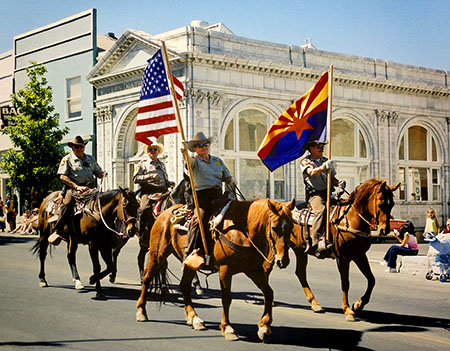December 12th, 2014
This article was originally printed in this paper on May 24, 2009.
Charles Lindbergh or his plane the Spirit of St. Louis might not be remembered by the world if an Italian seaplane The Santa Maria had not sunk to the bottom of Roosevelt Lake.
The Santa Maria, a Savoia Marchetti SM-55 torpedo bomber made of spruce, ash and fabric, left the Cagliari, Sardinia on February 13, 1927 on a goodwill tour. Italian Navy Commander Francesco Marquis de Pinedo, along with co-pilot Captain Carlo del Prete and mechanic Lieutenant Vitale Vacchetti had come 23,000 miles across the Atlantic, reaching Arizona in the southwestern United States.
Rough-water stability was provided the plane via twin hulls. A thick internally-based cantilever wing spanned 78 feet. A pair of 400 horsepower V-type Issota Frascini engines were mounted back-to-back above the wing on struts. While one propeller pulled, the other pushed. An open cockpit for the crew sat in the center section of the wing, between the two propellers. The aircraft weighed six tons and could fly 127 miles per day. It could not be caught by biplane fighters of the day. Extra gasoline tanks replaced heavy armament.
De Pinedo wanted to find lakes where the plane could refuel while he was over the Southwest. The Santa Maria left Elephant Butte Reservoir in New Mexico on April 6th headed for Roosevelt Lake.
The big silver plane came in over Dutch Woman Butte and landed to the delight of many proud local Italians who were at Roosevelt Lake for the big event. The airplane was worked to a mooring just below the Apache Lodge by two boats with outboard motors.
De Pinedo saw to the refueling and it appeared that more fuel was put into the plane than what it could take off with. A bucket of gasoline was offered by De Pinedo to anyone who wanted it. When no one spoke up, he tossed it overboard and instructed Del Prete and Vacchetti to dump more gasoline. It was then time for lunch at the Apache Lodge.
A cry was heard during dessert, and all rushed out to find a pall of black smoke. Fire extinguishers were of no use and The Santa Maria sizzled and sank.
John Thomason, a 17-year boatman, confessed that his cigarette had started the fire.
After shaking hands with the frightened young man, De Pinedo hitched a ride to Phoenix. Eventually he reached New York where another SM-55 arrived via a ship from Rome. Lindbergh flew to Paris on May 21.
Although the Apache Lodge later burned, its foundation remained and became a popular picnic spot.
The airplane is under at least 180 feet of water and 40 or more feet of silt under normal conditions, according to Salt River project engineers.
The original loss was paid to the Italian government by Lloyds of London.
Perhaps someday, someone will launch a major dredging operation and bring up the infamous Santa Maria. back...
Charles Lindbergh or his plane the Spirit of St. Louis might not be remembered by the world if an Italian seaplane The Santa Maria had not sunk to the bottom of Roosevelt Lake.
The Santa Maria, a Savoia Marchetti SM-55 torpedo bomber made of spruce, ash and fabric, left the Cagliari, Sardinia on February 13, 1927 on a goodwill tour. Italian Navy Commander Francesco Marquis de Pinedo, along with co-pilot Captain Carlo del Prete and mechanic Lieutenant Vitale Vacchetti had come 23,000 miles across the Atlantic, reaching Arizona in the southwestern United States.
Rough-water stability was provided the plane via twin hulls. A thick internally-based cantilever wing spanned 78 feet. A pair of 400 horsepower V-type Issota Frascini engines were mounted back-to-back above the wing on struts. While one propeller pulled, the other pushed. An open cockpit for the crew sat in the center section of the wing, between the two propellers. The aircraft weighed six tons and could fly 127 miles per day. It could not be caught by biplane fighters of the day. Extra gasoline tanks replaced heavy armament.
De Pinedo wanted to find lakes where the plane could refuel while he was over the Southwest. The Santa Maria left Elephant Butte Reservoir in New Mexico on April 6th headed for Roosevelt Lake.
The big silver plane came in over Dutch Woman Butte and landed to the delight of many proud local Italians who were at Roosevelt Lake for the big event. The airplane was worked to a mooring just below the Apache Lodge by two boats with outboard motors.
De Pinedo saw to the refueling and it appeared that more fuel was put into the plane than what it could take off with. A bucket of gasoline was offered by De Pinedo to anyone who wanted it. When no one spoke up, he tossed it overboard and instructed Del Prete and Vacchetti to dump more gasoline. It was then time for lunch at the Apache Lodge.
A cry was heard during dessert, and all rushed out to find a pall of black smoke. Fire extinguishers were of no use and The Santa Maria sizzled and sank.
John Thomason, a 17-year boatman, confessed that his cigarette had started the fire.
After shaking hands with the frightened young man, De Pinedo hitched a ride to Phoenix. Eventually he reached New York where another SM-55 arrived via a ship from Rome. Lindbergh flew to Paris on May 21.
Although the Apache Lodge later burned, its foundation remained and became a popular picnic spot.
The airplane is under at least 180 feet of water and 40 or more feet of silt under normal conditions, according to Salt River project engineers.
The original loss was paid to the Italian government by Lloyds of London.
Perhaps someday, someone will launch a major dredging operation and bring up the infamous Santa Maria. back...

